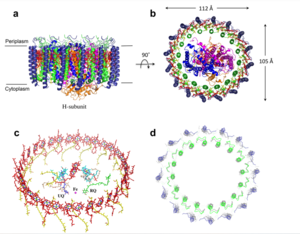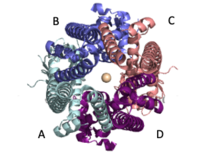Sandbox Reserved 1607
From Proteopedia
(Difference between revisions)
| Line 22: | Line 22: | ||
===Selectivity Filter=== | ===Selectivity Filter=== | ||
| - | The <scene name='83/832933/Selectivity_filter/2'>selectivity filter</scene> contains Glu358, Trp354, and Pro359 to allow calcium to pass through the uniporter. The carboxylate oxygen of the <scene name='83/832933/Glu_358/2'>Glu358</scene> side chains draw in the positive calcium ion. The <scene name='83/832933/Diameter/1'>diameter</scene> of the carboxyl ring is about 4Å, allowing only a dehydrated | + | The <scene name='83/832933/Selectivity_filter/2'>selectivity filter</scene> contains Glu358, Trp354, and Pro359 to allow calcium to pass through the uniporter. The carboxylate oxygen of the <scene name='83/832933/Glu_358/2'>Glu358</scene> side chains draw in the positive calcium ion. The <scene name='83/832933/Diameter/1'>diameter</scene> of the carboxyl ring is about 4Å, allowing only a dehydrated Ca2+ ion to bind. Trp38, which is directly next to the Glu residues, stabilizes the carbonyl side chains through <scene name='83/832933/H_bond_trp354_glu358/2'>hydrogen bonding</scene> and anion pi interactions. These Trp residues also form stacking interactions with Pro359, which orientate the Glu carboxyl side chains towards the middle of the pore to interact with Ca2+ ions. |
[http://www.rcsb.org/structure/6DT0 Calcium Uniporter Structure] | [http://www.rcsb.org/structure/6DT0 Calcium Uniporter Structure] | ||
| Line 41: | Line 41: | ||
===Heart Failure=== | ===Heart Failure=== | ||
| - | Calcium overload in the mitochondria of cardiac cells lead to apoptotic cardiac cell death. | + | Calcium overload in the mitochondria of cardiac cells lead to [https://en.wikipedia.org/wiki/Apoptosis apoptotic] cardiac cell death. Calcium governs [https://en.wikipedia.org/wiki/Cardiac_excitation-contraction_coupling excitation contraction coupling] (EC coupling) of the cardiac muscles, which creates the ATP needed to power the contraction during heart beats. The increase in mitochondrial Ca2+ concentration is essential for the functioning of this muscle contraction. Mitochondrial Ca2+ overload, though, leads to necrotic cardiac cell death and can be targeted with regulation of the MCU. An example of treatment would be with the use of Ru360 (Figure 3) to inhibit the uptake of Ca2+ ions into the mitochondria. |
| - | + | ||
| - | + | ||
| - | + | ||
| - | + | ||
== Student Contributors == | == Student Contributors == | ||
| - | + | *Holly Rowe | |
| + | *Lizzy Ratz | ||
| + | *Madi Summers | ||
</StructureSection> | </StructureSection> | ||
== References == | == References == | ||
<references/> | <references/> | ||
Revision as of 03:53, 7 April 2020
Mitochondrial Calcium Uniporter
| |||||||||||
References
- ↑ Hanson, R. M., Prilusky, J., Renjian, Z., Nakane, T. and Sussman, J. L. (2013), JSmol and the Next-Generation Web-Based Representation of 3D Molecular Structure as Applied to Proteopedia. Isr. J. Chem., 53:207-216. doi:http://dx.doi.org/10.1002/ijch.201300024
- ↑ Herraez A. Biomolecules in the computer: Jmol to the rescue. Biochem Mol Biol Educ. 2006 Jul;34(4):255-61. doi: 10.1002/bmb.2006.494034042644. PMID:21638687 doi:10.1002/bmb.2006.494034042644
- ↑ Yoo J, Wu M, Yin Y, Herzik MA Jr, Lander GC, Lee SY. Cryo-EM structure of a mitochondrial calcium uniporter. Science. 2018 Jun 28. pii: science.aar4056. doi: 10.1126/science.aar4056. PMID:29954988 doi:http://dx.doi.org/10.1126/science.aar4056



